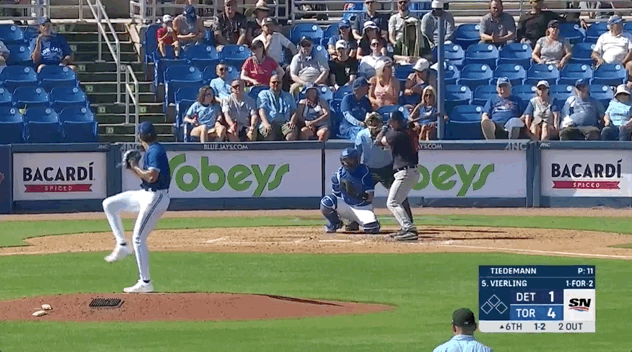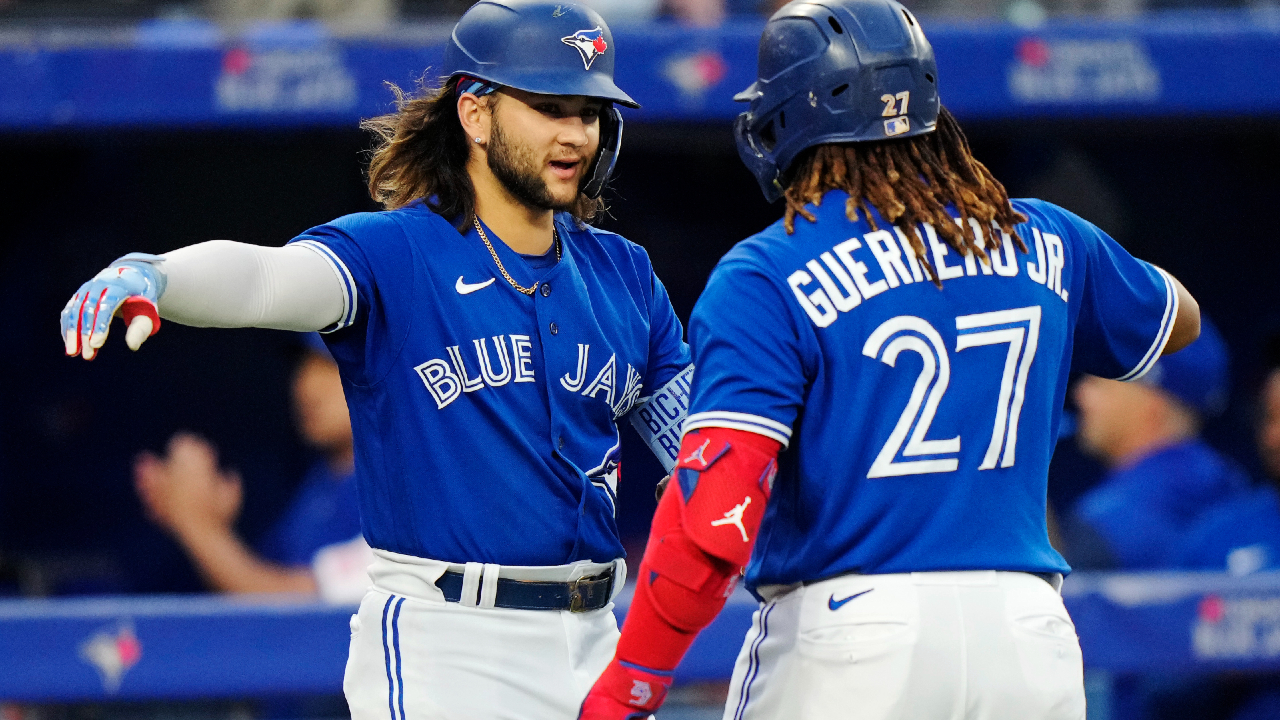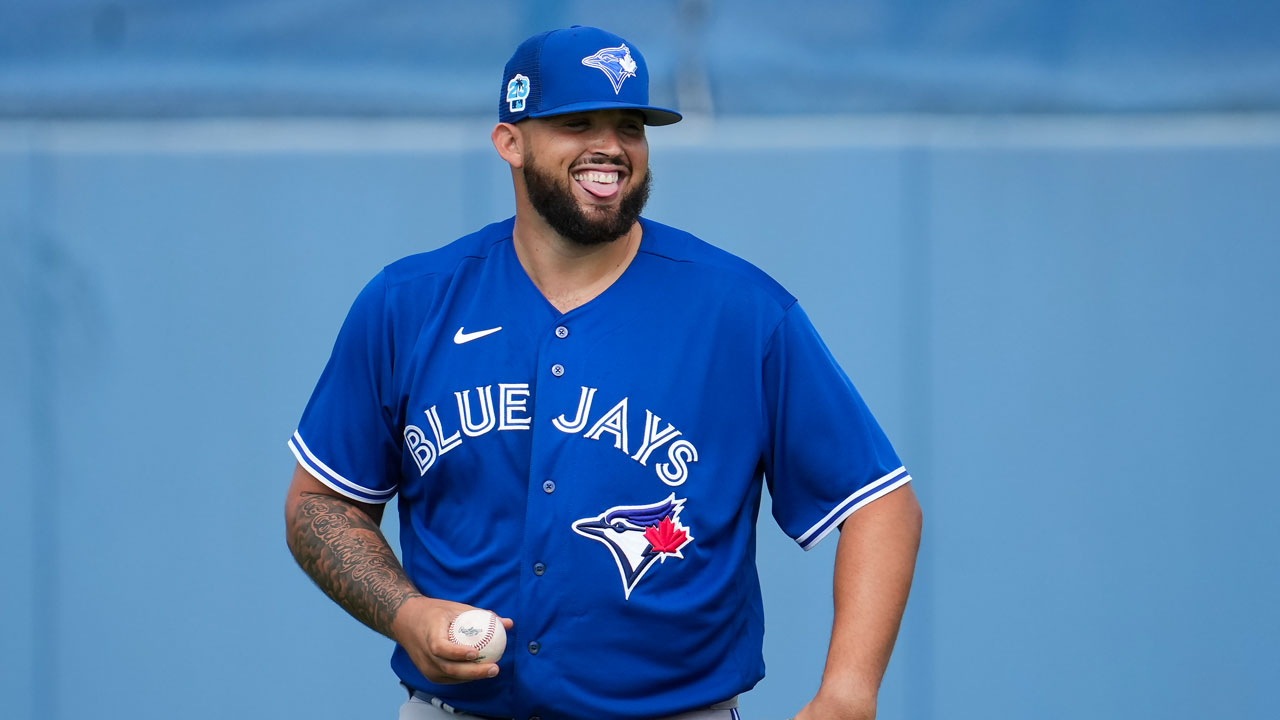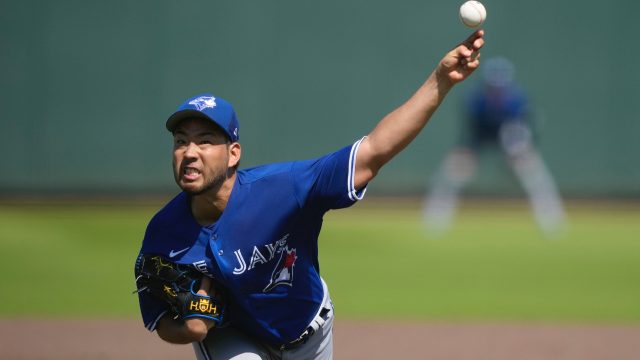
DUNEDIN, Fla. — In October 2021, as Toronto Blue Jays minor-league catcher Phil Clarke was preparing for his day at the club’s instructional camp, a coach told him he’d be catching a bullpen for one of the organization’s recent draftees that morning. Young left-hander out of a California junior college. Big kid. Big stuff.
“I’d never met him — had no idea who he was. I just chatted with him quickly and asked what he throws. He’s like, ‘fastball, slider, changeup,’” Clarke remembers. “I didn’t know it was going to be the best fastball, slider, changeup mix I’ve ever seen. I was like, ‘Whoa, this kid’s special.’”
That kid’s Ricky Tiedemann. Perhaps you’ve heard the name. The top prospect in Toronto’s organization; a top-35 MLB prospect no matter which list you prefer; featuring a high-90’s fastball, sweeping slider, and changeup mix that, as Clarke indicated, looks pretty special.
Appearing in his first major-league spring training only a year-and-a-half after he was drafted, the 20-year-old’s been demonstrating what all the hype’s about. Here’s the fastball zipping right over Javy Baez’s bat at the height of the zone:
This is the slider dotted on the outside edge for a first-pitch strike against Matt Vierling:
And here’s the changeup, which Clarke describes as Tidemann’s “most consistent pitch — it comes out the same as his fastball, gets to the hitter, and then the bottom just falls out:”
“Catching him that day at instructs, and even at double-A, I was just setting up down the middle and letting his stuff do its thing. Because it’s so nasty,” Clarke says. “The kid’s different. Just his demeanour, his stuff, everything. It’s just different.”
“Oh yeah, his fastball speaks for itself. It definitely comes out a little different,” confirms Andres Sosa, who caught Tiedemann’s first three starts with high-A Vancouver last season. “But he can also really pitch. He uses his off-speed well, lands his changeup early, back-foots his slider to righties. He’ll manipulate the outside corner. He’ll break a lot of bats. He gets a lot of uncomfortable swings.”
“And hitters knew it going in. They knew what they were about to face and that it wasn’t going to be a comfortable at-bat,” adds Zach Britton, who also caught Tiedemann with Vancouver. “I remember, we were in Hillsboro. The leadoff hitter steps in after Ricky threw his warm-up pitches and he just looked at me and went, ‘Well, shit. Here we go.’”
Now, some caveats. The pitches above are from Tiedemann’s first spring training appearance last week, a day he was undoubtedly full of adrenaline, eager to impress, and airing out his stuff in one inning of work. He’s not going to sit in the upper 90’s with his fastball as a starter when the spotlight’s less bright and he’s trying to complete two trips through the order.
But sitting 94-96 from the left side will certainly play. So, too, will the first-pitch breaking balls for strikes, a well-disguised changeup with 35 inches of vertical break, a deceptive low-slot delivery from the first base side of the rubber, and a stoic demeanour that rarely displays a hint of emotion as Tiedemann pounds the zone regardless of how well or poorly his day’s going.
Clarke remembers one in Hartford last August. Coming off the worst outing of his brief professional career, in which he coughed up four runs over two innings, Tiedemann fell behind his first hitter, 3-0, then proceeded to strike out the side. When he reached his 65-pitch limit, he’d struck out five of the nine batters he faced and hadn’t allowed a hit. It was only a day after Tiedemann’s 20th birthday. The average age of the level he was pitching at was 25.
“And you’d never know. He carries himself like a big-leaguer,” Clarke says. “Hartford is probably the best environment in all of double-A baseball. Brand new stadium, they fill it up with over 10,000 every night. It’s buzzing there. And he was unfazed. He just went out and attacked from the beginning. It was super impressive.”
You hear that word used to describe Tiedemann a lot — unfazed. Rob Brantly offered it after catching Tiedemann’s second start of spring training Tuesday, an outing that didn’t go nearly as well as his first.
It started spinning quickly. As he settled in for his first pitch of the day to Andrew McCutchen, Tiedemann discovered his PitchCom was malfunctioning, causing a delay that brought a smattering of chirps from the Pittsburgh Pirates dugout and a cascade of boos from the 5,000 in attendance. And even after Tiedemann was supplied with a new earpiece, he struggled to properly align it in his hat and had trouble hearing the pitches Brantly was calling.
As pitch clocks ticked down around him, Tiedemann got sped up in his delivery and left a changeup over the heart of the plate to McCutchen, who chopped it to third for an infield single. Next pitch, still rushing against the clock, Tiedemann left a 97-mph heater on the outter half to Carlos Santana, who was cheating to the fastball and went with it over the right field wall. Three pitches thrown, two runs on the board, one PitchCom still out of place above Tiedemann’s right ear.
“There was a lot going on. We got into a little bit of hurry-up baseball there. A little too quick of a rhythm. And Santana’s a good hitter, man. He recognizes that. He sold out for the heater. And that’s going to happen sometimes,” Brantly said. “But that didn’t shake Ricky at all. He answered straight back. Stayed competitive. He answered back like a big-leaguer, honestly. Threw a strike the very next pitch. Controlled his time. Unfazed.”
There’s that word again. But it’s fitting as Tiedemann followed Santana’s homer with a 97-m.p.h. fastball down in the zone. He threw nine of his next 15 pitches for strikes, exiting the inning without further damage thanks partly to an out on the basepaths, but also to a well-received back-door slider to a righty for a called third strike and a crafty pickoff that erased a walk.
Back out for a second inning of work, Tiedemann breezed through the side on six pitches, getting a soft groundout with a fastball and a routine flyball with a slider before carving up Rodolfo Castro for a three-pitch strikeout and stalking off the mound:
Between innings, Brantly made a point of telling Tiedemann to continue trusting his fastball and stay aggressive. The veteran catcher’s beginning his 14th professional season. He’s caught plenty of young pitchers eager to impress in their first big-league camps. He’s seen this story before. Turning the page on a rough inning doesn’t come easily for 20-year-old’s facing the game’s best hitters for the first time in their life.
“I just said, ‘Look, your fastball got hit. Let’s not shy away from it. Let’s keep going after these guys,’” Brantly said. “And he comes out and just keeps pounding the zone, pounding the zone. Then he drops a really good slider in there, back-foot. And all of a sudden, we’re back in the dugout.
“That’s huge. Because, look, you’re going to give up your homers. It’s how you respond. Are you going to stay competitive through six, seven, eight innings and take that off your bullpen? He showed today he can be that guy. Trust me, everybody sees that.”
These are the kinds of challenges the Blue Jays want to see Tiedemann rise to. It’s undeniable that he could get MLB hitters out today. He could’ve gotten them out last season when he was dominating three minor-league levels. But the Blue Jays aren’t trying to develop a leverage reliever here. They’re trying to develop a front-of-the-rotation starter who’s taking the mound to begin postseason games. They’re trying to develop another Alek Manoah.
And the foundation of that is an intelligent, carefully considered, dynamic workload progression informed by data and evidence. Last spring, the Blue Jays sat down with Tiedemann and mapped out their vision of his progression in his first professional season. It would start in A-ball but could end as high as double-A if Tiedemann continually proved he was too advanced for the level he was at.
He’d pitch once a week on Friday’s, going as long as five innings and as many as 85 pitches if he was holding his stuff. There would be no arbitrary innings limit for his season — it’s not 2006. But the club would be mindful of the teenager’s overall workload and the fact he was coming off a pandemic-shortened, 38-inning Junior College season that hadn’t tested him like a true professional one would. The ultimate goal was a strong, foundational season he could build upon in 2023.
“I think they’re just trying to be careful. My last season before I got to pro ball was during COVID — so, I only pitched seven games,” Tiedemann says. “They’re just trying to ease me into pro ball and help me get into my routine so that, week in and week out, I can feel the same way. They’re doing the right thing.”
Tiedemann buying into this process is crucial. Particularly at junctures like last July when, after his 14th start of the season and as he was about to pitch in MLB’s Futures Game, the Blue Jays pulled him from competition and brought him to the club’s player development complex in Dunedin, Fla. for three weeks.
There was nothing acutely wrong with Tiedemann that caused the club to utilize MLB’s development list — a recently established tool that allows organizations to assign minor-league players to club facilities for the purpose of conditioning or development without them counting against an affiliate’s active roster limit — to summon him for a mid-season look under the hood.
Toronto’s player development staff merely wanted to manage Tiedemann’s workload, measure how his strength and conditioning was holding up over his first full season, and assess his delivery for any unideal habits or tendencies that could be creeping in. Think release point, arm slot, spin efficiency. Throwing before high-speed cameras capturing super slow motion footage, wearing motion capture sensors gathering biomechanical data, on mounds with force plates within them measuring power output.
What they discovered was Tiedemann’s metrics and assessments were all virtually level with the ones they’d taken during spring training. He’d thrown 67.2 innings since, and a career-high 84 pitches in his final outing with Vancouver before being placed on the development list. But he wasn’t showing as much wear as the club expected.
That told the Blue Jays Tiedemann was nailing his strength, conditioning, and arm care routines between starts. That he was eating, sleeping, and lifting in beneficial ways. That he was managing stress, prioritizing recovery, avoiding over-training — all the things they’d been teaching him since he arrived in their environment a year prior.
“There’s a lot of things I didn’t know before I got into pro ball, routine-wise. Everything I went through last year definitely helped me get my stuff together,” Tiedemann says. “A lot of arm care. Mobility work. A lot of stuff in the weight room. Things you shouldn’t do on the days prior to your start, how to properly recover after. There’s certain lifts that you don’t want to do the day before. Certain lifts you should do the day after. Just how to set it up right to where your body feels 100 per cent going into each game.”
You’ll see the Blue Jays utilizing that mid-season check-in model more broadly this season. Maybe even with Tiedemann again. But it won’t only be top prospects sticking to workload plans. Think starters who are having trouble carrying their stuff through outings; relievers who over-trained during the winter and are now struggling to recover between appearances; hitters mired in slumps while carrying minor injuries and fighting the mental demands of daily competition.
Going forward, the Blue Jays will endeavour to give players like that a breather from affiliate life, get them in Dunedin’s labs to assess any areas of concern, and send them back out to an affiliate after a week or two with a cleared head and refreshed body. It’s a framework the club’s been considering for years but didn’t have the means to facilitate until the opening of its new player development complex.
And it worked for Tiedemann, who was aggressively assigned to double-A from his Dunedin sabbatical and pitched to a 2.45 ERA over his final 11 innings of the season, striking out 14 while walking four.
“It’s good to have. They put you in the lab, you throw a little bit. You see where your stuff’s at. As the season goes on, there’s a lot of things that happen as you build up fatigue. It’s good to see how that’s affecting you,” Tiedemann says. “But, at the same time, even if something’s a little bit down or other things are a little bit up, you’ve still got to go out there and do the same things. You still have to compete.”
There’s no question Tiedemann does that. What’s unknown is how his 2023 workload builds upon 2022’s. It’s not as simple as pencilling him in for a little over 100 innings after he topped out at 78.2 last season. Not all innings are created equal. They’re a measure of outs — and some outs come on one pitch, some on 12. It’s a poor gauge of workload.
Rather, the club will monitor the objective data they gather on Tiedemann’s performance throughout the season and use that to inform the process. How he’s holding his stuff, the strength he’s demonstrating in the weight room, his levels of central nervous system fatigue. They’ll use a Catapult wearable and Hawkeye tracking technology. They’ll assess and adjust strategy as they go. They’ll formulate an individualized plan with him this spring, just as they did last, and adapt it on the fly according to the performance and measurables he’s producing.
The ultimate goal is having Tiedemann available for summer and fall, when his high-octane arm could make a dramatic impact on an MLB postseason race — and even on a postseason mound. That will likely mean preserving ammunition with shorter outings of 3-4 innings or 40-50 pitches back at double-A to begin the year before a potential mid-season triple-A call-up if Tiedemann’s proving the level is no longer challenging him.
Provided all’s going well, the length of Tiedemann’s outings will increase in turn. And if things really go well, Tiedemann could be on a major-league mound in a Blue Jays uniform sometime during the back-half of the season. That could be as a starter; could be out of the bullpen. It’ll depend on need. And, of course, on Tiedemann checking every box along the way.
Not that anyone expects otherwise. Ever since that first bullpen he threw to Clarke at an instructional camp 16 months ago, Tiedemann’s been on a rocket to the game’s highest level at the same expedited pace Manoah travelled. They’re such different pitchers, yet impossible not to connect. The talent, the stuff, the demeanour. Composed, unfazed, different. Couple big kids with big stuff.
“That’s who we were all comparing him to at instructs,” Clarke says. “Because it was right after Manoah debuted and had that amazing year. And then Ricky turns up, and it took one bullpen for everyone to be like, ‘This kid’s unbelievable. We’ve got another special arm in the org.’ Everyone was like, ‘We got another Manoah.’”












